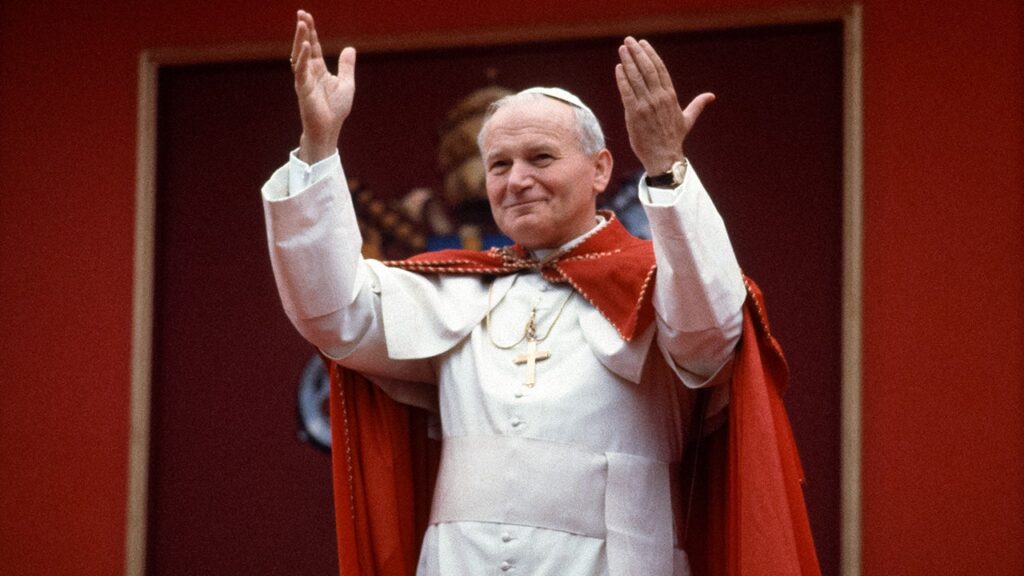On September 10, 1987, Pope John Paul II touched down in Miami, Florida, marking the beginning of a monumental 10-day tour of the United States. This significant event was met with an enthusiastic welcome from President Ronald Reagan and First Lady Nancy Reagan, alongside a crowd of thousands of eager supporters. Upon his arrival, Pope John Paul II emphasized his mission, stating, “I come as a pilgrim, a pilgrim in the cause of justice and peace and human solidarity, striving to build up the one human family.” His heartfelt remarks were delivered in English from a stage adorned with a canopy at Miami International Airport, as reported by The New York Times. The vibrant audience celebrated with flags and donned the yellow-and-white colors associated with the papacy, reflecting a spirit of jubilation and unity.
During the welcoming address, President Reagan drew attention to Florida’s sweltering heat, remarking that “Today’s Florida sunshine is no warmer than the greeting you will meet in this country.” This warm reception illustrated the excitement surrounding the Pope’s visit and set the tone for the subsequent events throughout his nearly 27-year pontificate. Pope John Paul II’s U.S. visits were numerous, with seven trips planned across his tenure, each contributing to his legacy as a pontiff connected to the faithful.
In Miami, Pope John Paul II engaged in several notable activities, orchestrating a series of historic gatherings. Among these was a meeting with representatives of the nation’s priests at St. Martha Church located in Miami Shores. He also held a groundbreaking conversation with leaders of the U.S. Jewish community, fostering dialogue that eventually contributed to the Vatican’s recognition of Israel. One of the most memorable highlights of his visit was a parade down Biscayne Boulevard aboard his “popemobile,” which showcased the Pope’s enduring connection with the people.
A remarkable outdoor Mass at Tamiami Park drew an astonishing crowd of over 200,000 participants. The event became particularly dramatic as it was momentarily interrupted by torrential rain, accompanied by flashes of lightning and ominous thunder. Despite the inclement weather, Pope John Paul II continued the celebration in a nearby trailer before reemerging to bless those who had braved the storm, a testament to his commitment to his followers. This visit, aligned with the theme of unity, showcased Miami’s rich multicultural fabric, highlighted by the presence of Cuban flags, Polish Solidarity banners, and a fusion of musical traditions ranging from Spanish to Creole, alongside Gregorian chants. The Mass itself was a multilingual celebration, further emphasizing the diversity of the attendees.
Beyond Miami, the Pope toured various major American cities including Columbia, South Carolina; New Orleans; San Antonio; Phoenix; Los Angeles; Monterey; San Francisco; and Detroit. Notably, this trip represented the longest duration of Pope John Paul II’s visits to the United States and marked his inaugural journey to the contiguous West Coast. His engagements included addressing representatives of Black Catholics at the Superdome in New Orleans and facilitating an ecumenical conference at the University of South Carolina. Additionally, he celebrated a historically attended Mass in San Antonio, drew crowds in Phoenix at the Tekakwitha Conference, and met members of the communications industry in Los Angeles.
Pope John Paul II, originally named Karol Wojtyla, was born in Wadowice, Poland, on May 18, 1920. He ascended to the papacy on October 16, 1978, serving as a revolutionary figure until his death on April 2, 2005. He was notably the first non-Italian pope since the 16th century and earned the distinction of being the most traveled pope in history, visiting 129 countries during his papal tenure, which included significant visits to Cuba and Haiti.
His legacy is profound, marked by his pioneering efforts to bridge divides among various faiths and his significant contributions toward undermining communist regimes across Eastern Europe. Among his landmark achievements, he was the first pope to visit the White House, the United Kingdom, and a mosque in Greece. He also held historic meetings with interfaith leaders and offered the Catholic Church’s first formal apology regarding its actions during World War II.
Pope John Paul II passed away on April 2, 2005, at the age of 84, with two million mourners attending his funeral in Vatican City just six days later. His successor, Cardinal Joseph Ratzinger, became Pope Benedict XVI, who was later succeeded by Pope Francis in March 2013. In April 2014, Pope John Paul II was canonized, solidifying his enduring legacy within the Catholic Church and the broader context of global interfaith dialogue.



